Most birds spend hours, days, or even weeks painstakingly building their nests. Some birds make nests out of mud, while others build nests in trees. Still, other birds that nest on the ground simply scrape out a simple depression. Meanwhile, some birds, such as the winter wren, build intricate domed nests out of grasses and lichens. Birds build their nests during the breeding season to hold their eggs and some may even end up making multiple nests. Nests must be carefully constructed to not only hold eggs but also protect them from predators. Several species prey on bird eggs including snakes, foxes, rodents, and even other birds. That said, there exists a separate subset of birds that go a different route. These criminals steal other birds’ nests through a combination of trickery and brute force. Meet the common cuckoo; the bird that steals nests.
Due to its deceitful behavior, the common cuckoo is one of the world’s most infamous birds. Given its unique form of brood parasitism, it deserves special attention for us to understand how these birds benefit from other birds’ labor. In this article, we’ll cover the common cuckoo’s taxonomy, distribution, physical characteristics, diet, nest stealing behavior, chick behavior, and importance ecologically and culturally. We’ll also answer a few frequently asked questions about the common cuckoo, the bird that steals nests.
Taxonomy
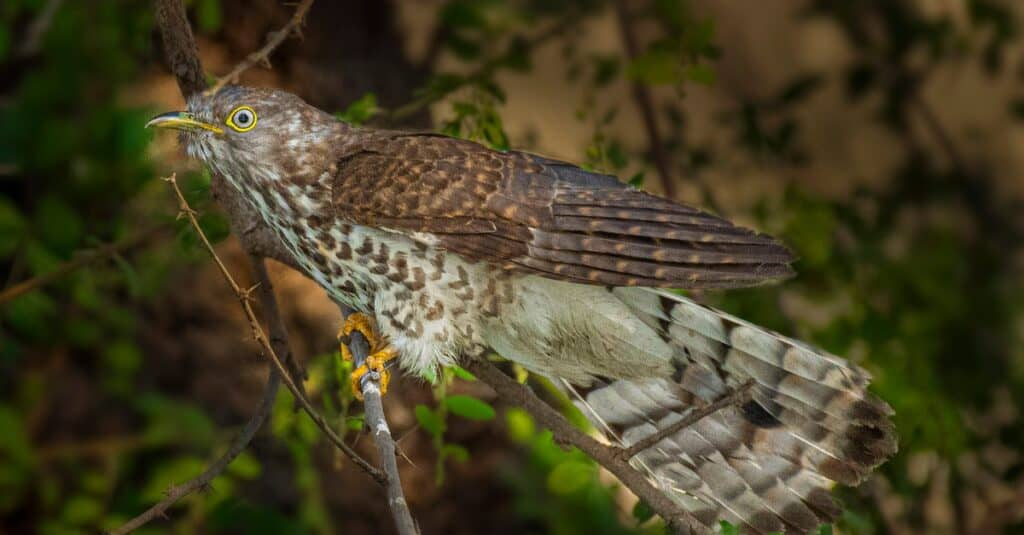
The cuckoo family also includes roadrunner, does, couas, coucals, anis, and malkohas.
©iStock.com/Rajukhan Pathan
The common cuckoo belongs to the cuckoo family Cuculidae. This family also includes roadrunners, doels, couas, coucals, anis, and malkohas. In Latin, the common cuckoo’s name, Cuculus canorus, translates to “the melodious cuckoo.” This alludes to the unique vocalizations of the male common cuckoo, which onomatopoeically sound like “cuckoo.” Furthermore, the word “cuckoo” also has origins in the French word cucu, which traces back nearly 800 years to old poetry and songs. Today, scientists recognize four different subspecies of the common cuckoo. When most people think of the common cuckoo, they typically think about the nominate subspecies, C. c. canorus. That said, the other three subspecies include C. c. bakeri, C. c. bangsi, and C. c. subtelephonus.
Distribution
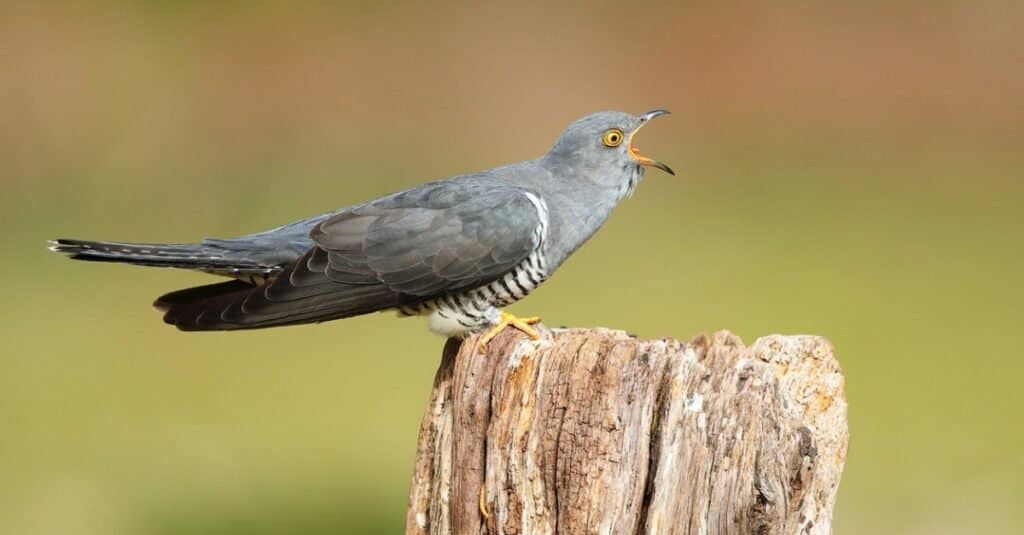
Most cuckoos spend their spring and summer in Europe or Asia and winter in
Africa
or South Asia.
©iStock.com/Bebedi
Common cuckoos spend the spring and summer in Europe and Asia and overwinter in Africa. That said, the distribution of the common cuckoo varies depending on the subspecies. During summer, you generally find common cuckoos throughout the UK, Ireland, Spain, Scandinavia, Russia, Japan, China, Korea, Kazakhstan, Turkey, Mongolia, India, Nepal, Myanmar, and Thailand. Meanwhile, during winter common cuckoos spend time in Sub-Saharan Africa, southern India, Myanmar, and Thailand. Their preferred habitats include open areas with sparse tree cover including fields, scrubland, parks, and marshes. Overall, the common cuckoo’s global population trend is on the decline, with a total population of less than 100 million. However, given its widespread distribution, the IUCN still lists it as a species of Least Concern.
Physical Characteristics

Common cuckoos often get mistaken for the Eurasian
sparrowhawk
.
©Wirestock Creators/Shutterstock.com
On average, common cuckoos measure around 13 inches long with a wingspan between 22 to 24 inches. They sport a long, slender body and tail, although their legs appear quite short in comparison. Their plumage appears predominantly gray, although some cuckoos feature rufous coloration, particularly as juveniles but sometimes as adults. Meanwhile, their underparts are barred with alternating dark and light stripes. In addition, a yellow ring encircles each of their eyes. People often mistake common cuckoos for the Eurasian sparrowhawk. In fact, other birds often make this same mistake. This can lead to birds vacating their nests when a common cuckoo appears, which helps the female cuckoo to lay her eggs undisturbed.
Diet
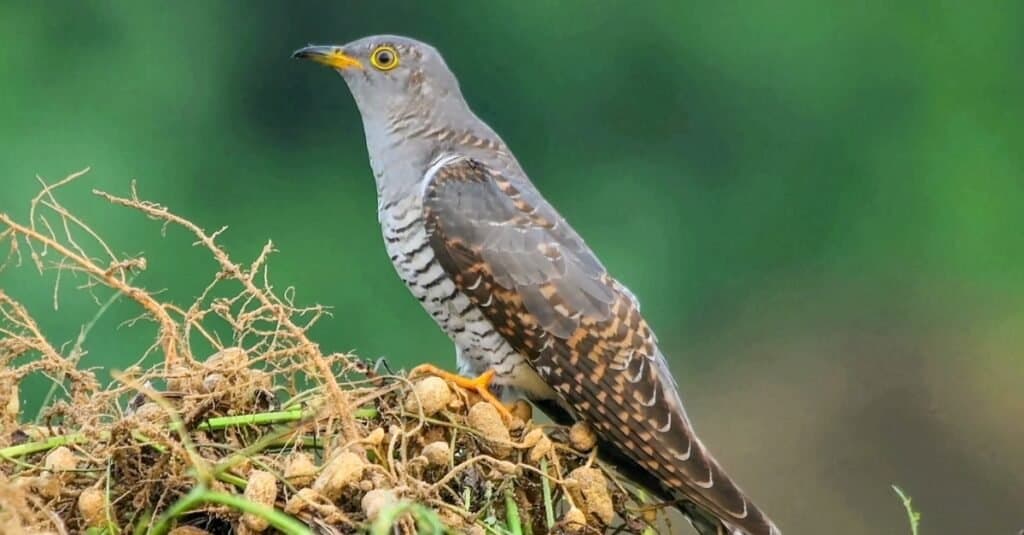
The common cuckoo mostly eats insects, particularly hairy caterpillars.
©iStock.com/Banu R
Common cuckoos are diurnal, meaning that they feed during the day and sleep at night. As insectivores, their diet primarily consists of insects. They will eat a wide variety of insects, including beetles, insect larvae, crickets, and dragonflies. In particular, they like to eat hairy caterpillars, which many other bird species avoid due to their unappetizing flavor. On occasion, common cuckoos will also eat the eggs and chicks over other birds. When feeding, common cuckoos normally feed on the ground and will run or hop after their prey. Upon catching a caterpillar, they may shake or bang it against a tree to remove its spines. However, they will also simply swallow a caterpillar whole without removing the spines first.
Nest Stealing Behavior

Common cuckoo females may lay their eggs in up to 50 different nests.
©iStock.com/Denja1
The common cuckoo is a brood parasite, meaning it lays its eggs in other birds’ nests. As a result, a common cuckoo female does not build her own nest and instead relies on other birds to raise her chicks. During the breeding season, a female cuckoo will deposit eggs in up to 50 different nests. Currently, scientists know of almost 300 different species that common cuckoos target as possible hosts for their eggs. While some females target a wide variety of species, others specifically target a small number of host species. Female cuckoos tend to target nests located closest to them, and often wait for their hosts to leave their nests unattended. They will incubate their eggs inside their bodies for a day before laying their egg in another bird’s nest. This ensures that the common cuckoo hatches first and can monopolize food and the host’s attention.
Chick Behavior
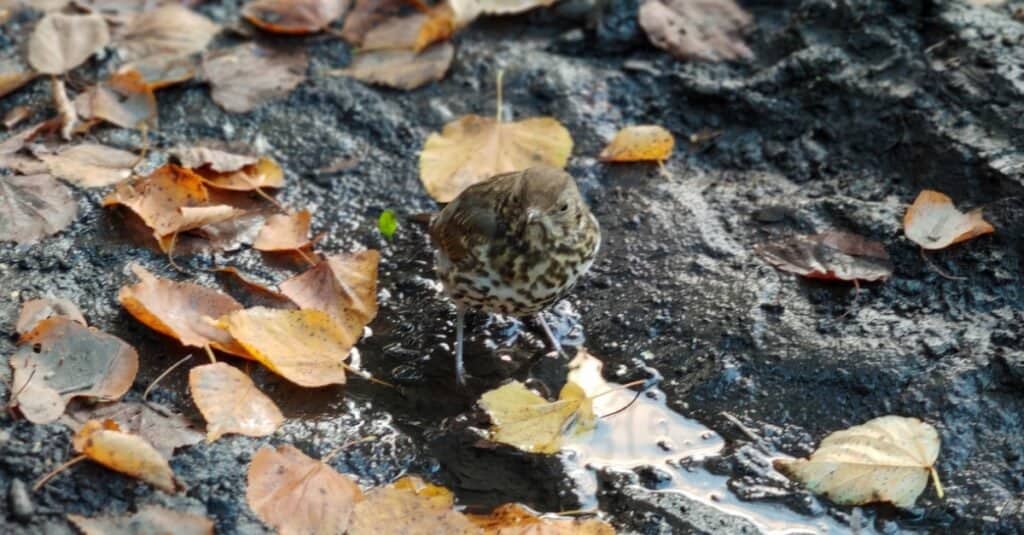
Common cuckoo chicks will push their host’s young out of their nest.
Upon hatching, the common cuckoo chick will push the host bird’s eggs or live young out of the nest. It’s normally able to do so because the cuckoo chick usually hatches before the host’s young. In the event that the host’s chicks hatch first, the larger, stronger cuckoo chick forcibly evicts the host’s young from the nest. According to popular consensus, cuckoo chicks evict the host’s chicks in order to monopolize food and attention. Common cuckoo chicks require a significant amount of food and fare poorly if they have to share food resources.
Ecological and Cultural Importance
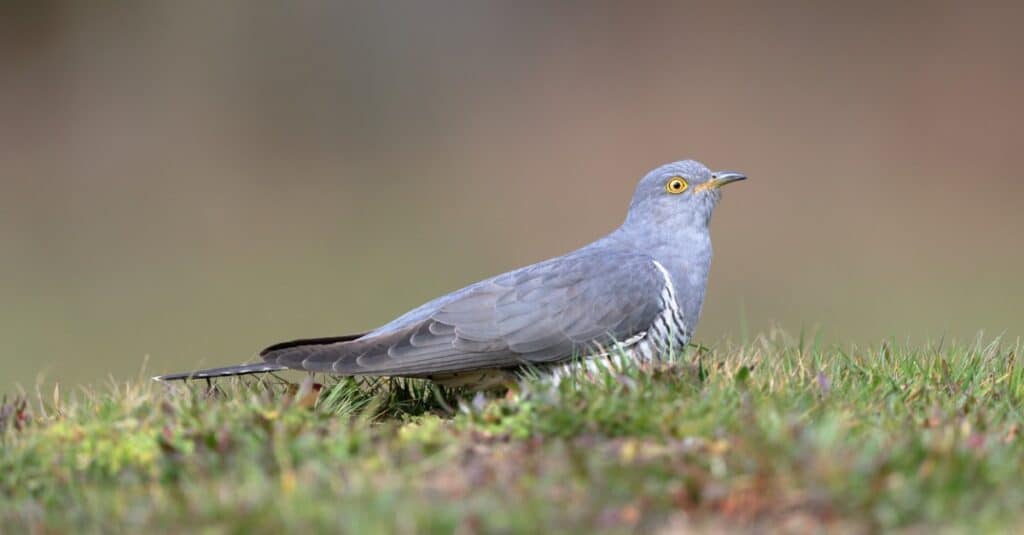
The common cuckoo is used by scientists to judge the biodiversity of a particular area.
©iStock.com/Bebedi
Scientists consider the presence of cuckoo chicks and cuckoos in general to be a good indicator of biodiversity in bird communities. The greater number of hosts that a cuckoo preys upon, the greater the biodiversity in that area. In addition, this bird that steals nests also serves an important cultural role in many regions. Common cuckoos appear in legends and songs, as well as in books and plays. In Europe, hearing the call of a cuckoo is a sign that spring is fast approaching. Also, the term cuckoo, which means “crazy” or “stupid,” comes from the cuckoo.
Frequently Asked Questions About Common Cuckoos
What animals prey on common cuckoos?
A number of species prey on common cuckoos. Predators include falcons and hawks such as the red-shouldered hawk and sparrowhawk.
How long do common cuckoos live?
According to records, the oldest known cuckoo lived to be 6 years, 11 months. That said, most cuckoos do not live this long in the wild.
The photo featured at the top of this post is © iStock.com/Sander Meertins
Thank you for reading! Have some feedback for us? Contact the AZ Animals editorial team.






